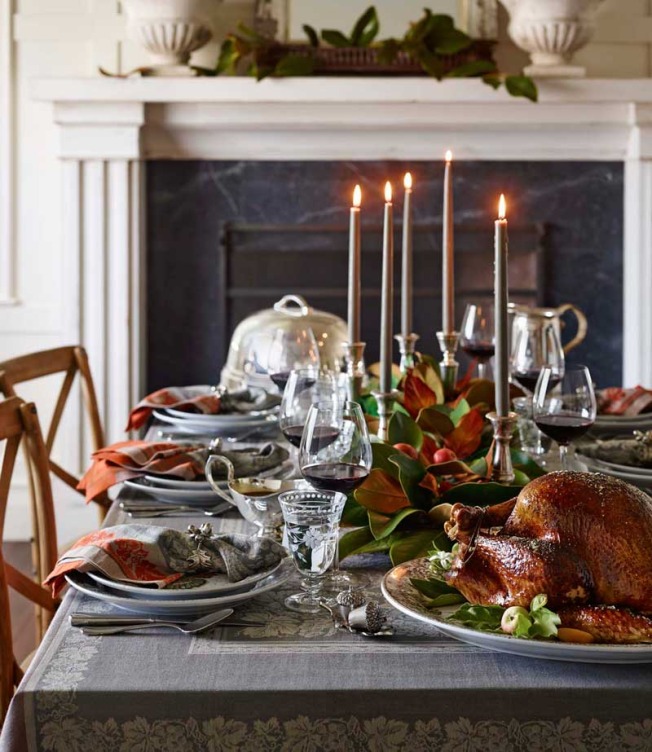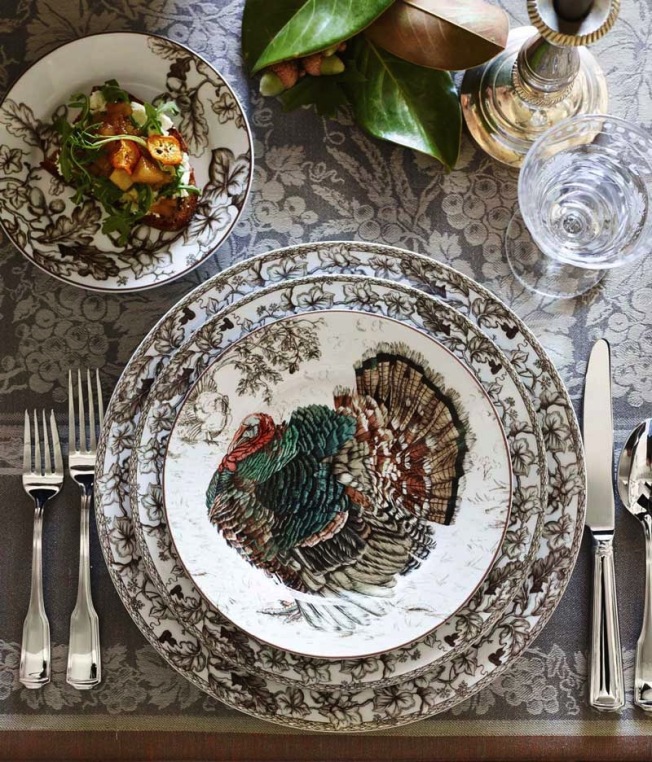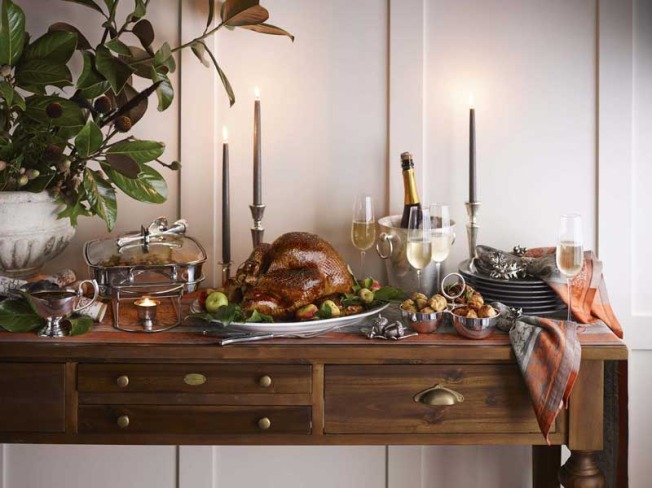More than any other holiday, Thanksgiving is celebrated with a bountiful table. By assembling the right balance of elements, any table can be made festive and beautiful. Start with something you know you want to use, such as the family silver or a mix of serveware, and let that be your guide as you consider the basic categories: dinnerware, glassware, flatware and linens.
Dinnerware
The plates and serving dishes you choose can help set the overall tone for your celebration. The pieces need not match. What is important is that everything has a harmonious style and palette. Large, plain white dinner plates are a good choice for both elegant and casual settings.
You can augment the plates with colored or patterned serving dishes to create a contemporary or traditional look. Family heirloom dishes are particularly appropriate for Thanksgiving. Unmatched serving pieces that complement your dishes and tableware can add warmth and charm to the dining table.
Glassware
Well-chosen glassware, even if unadorned and straightforward, lends sparkle and richness to the setting. Simple, classic stemware is always an appropriate choice for either a formal or casual Thanksgiving meal. Setting the table with water glasses and wineglasses that match (the water goes in the larger glass) is an easy way to create a sense of elegance.
Whether you are serving cocktails in pretty tumblers or hot cider in glass teacups, the basic principle remains the same: Be consistent, assembling glasses of similar quality and style for a given beverage. Even an inexpensive set of glasses can bring a table setting together, because its matching shapes and sizes create a sense of uniformity.
Flatware
Mixing and matching flatware adds a touch of homey charm to the holiday table, especially if you have an eclectic collection of vintage flatware. Good-quality stainless-steel flatware goes with virtually any setting, from modern and informal to traditional and elegant. Look for heavy pieces with thick handles. If you have a set of family silver, Thanksgiving is the ideal occasion to use it.
Linens
Your choice of linens, including the decision not to use a tablecloth, can define the look of the entire table. For most Thanksgiving settings, understated linens made of high-quality cotton or linen are an excellent choice. You can add color and interest to each place setting by folding or tying the napkin and incorporating a decorative element, such as a spray of foliage or autumn leaf that matches the centerpiece.
Your tablecloth and napkins do not need to match, but their style and colors should complement each other. For casual settings, be creative with a variety of colored napkins that fit your overall style.
Measure your table to determine whether it will work for the number of diners, and add or remove leaves or extensions as needed. A comfortable table setting, especially a formal one with a variety of glassware and flatware, should allow about two feet of space between the center of one plate and the center of the next.
The Formal Table
At a formal table, guests always have a plate in front of them. A charger, or large plate, is set at each place, and the first course is served on a small plate set atop the charger. The charger is replaced with a dinner plate when the main course is served.
To the left of the plate, place the napkin, its fold facing inward, with room for silverware to its right. You can also put the napkin on the plate, especially if it is attractively folded. Silverware is seldom placed directly on the napkin, as this makes it difficult for a diner to pick up the napkin. To the right of the napkin, place the forks in the order in which they will be used, from left to right. Put the knife on the right side of the plate with its blade facing inward, and set the soupspoon to the right of the knife. Put the dessert fork above the plate, parallel to the edge of the table and with its handle pointing to the left; above it, put the dessertspoon with its handle pointing to the right. If space is tight, you can bring the dessert implements out when the course is served.
Put a bread plate above the forks and lay a butter knife across its upper rim. Arrange glassware in a diagonal line starting above the knife, going up and to the left in order of use from closest to farthest. Set out a wineglass for each type of wine and, at the upper-left end of the diagonal, a water glass.
The Informal Table
For a casual Thanksgiving dinner or a meal served over the holiday weekend, consider setting the table without a cloth, especially if the table has an attractive wood or glass surface. Or, select a simple cotton tablecloth or place mats in a neutral color and complementary napkins with a similar look and feel. A long runner, laid over the bare tabletop or the tablecloth, in a similar or complementary fabric, is an easy way to dress up a casual dining surface.
You can use everyday plates, flatware and glassware, adding a few special pieces, such as an heirloom gravy boat, a modern vase or a fanciful platter, to enhance the holiday mood. Set a simply folded or rolled napkin on each plate, or to the left of the plate, with the folded side facing inward. Arrange flatware in the order in which it will be used, starting with the outermost item. Put forks on the left side of the plate, or to the right of the napkin. On the right side of the plate, put the knife, with its blade facing inward, and the soupspoon, if you are serving soup. Set a water glass above the knife and a wineglass to its right.
For an informal Thanksgiving, there is no need to clutter the table with butter plates and knives or dessertspoons or forks. Guests can put bread directly on their dinner plates, and spoons and forks can be brought out along with the dessert.
The Buffet
Choose a table or sideboard to use for the buffet, and arrange your serving platters on it ahead of time to make sure everything fits. You may wish to opt for a smaller buffet table, which gives a look of abundance, over a large one, which can appear sparse. If space allows, move the table away from the wall so guests have access to both sides.
Set the dinner plates at the end where the guests will start, and the napkins and silverware (if they are not set on the dining table) at the other end, so guests will not have to juggle too many items while serving themselves. Provide a serving utensil for each dish. In the remaining space, add a few decorative elements, such as candles or an arrangement that ties in with the table centerpiece.
For a large group, display the turkey or ham whole on the buffet as the guests gather, so they can admire it. Then carve the meat in the kitchen and return the carved slices to the buffet on a platter. For smaller gatherings, you can stand at the buffet and carve slices to serve to each guest. This makes for a more dramatic presentation and keeps the meat warmer and more moist.




3 comments
[…] around the table. With her knack for design and style she loves to take her creativity to the Thanksgiving table, styling a thoughtful dinner party for her guests that never feels fussy or […]
I have several table runners that are too long unless all the leaves are in my table. Is there a way to fold them so that I can use them on a regular basis on my shorter table?
Actually, napkin placement is with the fold facing outward. Corners are facing the plate, in the lower right of the napkin. This allows the diner to simply pick up the uppermost corner of the napkin and have the napkin gracefully unfold on it’s own, to easily drape across the diner’s lap.